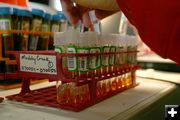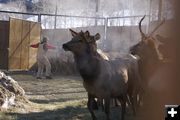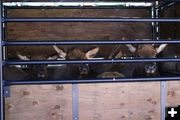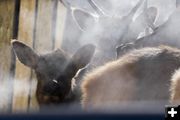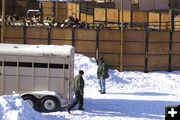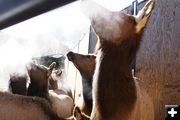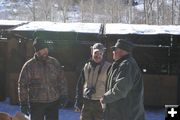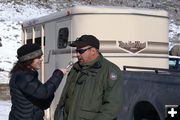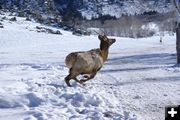
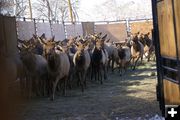
Herded
A group of elk move through the round pen in the elk trap. A total of 79 adult cow elk that were tested for brucellosis Monday spent a quiet night in a round pen in the elk trap while their blood samples were being analyzed in a portable laboratory in Pinedale. Photo by Cat Urbigkit.
|

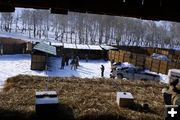
Trap Overview
This is the scene as work begins at the Muddy Creek elk feedground near Boulder on Monday as viewed from the top of the haystack. This is where Scott Werbelow of the Wyoming Game and Fish Department hid as he waited for enough elk to enter the elk trap. Laying on the bale is a handcounter and the electronic device that triggers the gate. Photo by Cat Urbigkit.
|

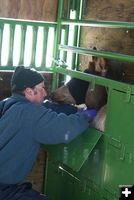
Blood Draw
Brandon Scurlock of WG&F draws blood from a neck vein of a cow elk held securely in a squeeze chute. Some animals may lack antibodies but may still be infected if they are incubating the bacteria. Killing animals that have a positive or a suspect test is generally necessary so that tissue samples can be obtained for bacteriological culture. Photo by Cat Urbigkit.
|

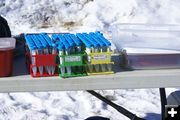
Elk blood
Empty blood vials await filling Monday on the supply table. With a temporary laboratory located in Pinedale to handle the blood samples, test results were available overnight. Elk that tested positive, or show antibodies for brucellosis, were shipped to Idaho for slaughter in a USDA approved facility early Tuesday morning, with the meat from the slaughtered animals to be donated to the public throughout Wyoming, as happened last year. Photo by Cat Urbigkit.
|

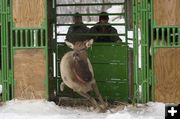
Released Elk
A seronegative elk that was released back to Muddy Creek feedground. Photo by Mark Gocke-Wyoming Game & Fish Department.
|

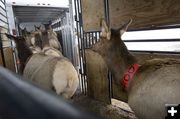
Loading on trailer
Elk were loaded into a trailer live, to be shipped to a
USDA inspected slaughter facility in Idaho. Photo by Mark Gocke-Wyoming Game & Fish Department.
|
|
Muddy Creek Elk Feedground Brucellosis Testing
by Cat Urbigkit, Pinedale Online!
January 31, 2007
Editor's Note: Selected members of the media were invited to attend and cover the Wyoming Game & Fish Department elk brucellosis trap and testing procedure at Muddy Creek Elk Feedground on Monday, January 29, 2007. Cat Urbigkit went for Pinedale Online! Here are her photos and comments from the day, as well as a press release and several photos from the Wyoming Game & Fish Department.
_______________________________________________
Muddy Creek Elk Feedground Brucellosis Testing
By Cat Urbigkit, Pinedale Online!
An interagency team converged on the Muddy Creek Elk Feedground near Boulder on Monday to trap and test the elk for brucellosis. When all was said and done, a total of 79 adult cow elk were tested, with 13 elk seropositive for brucellosis, meaning their blood indicated antibodies for the disease. Those animals were loaded into a stock trailer Tuesday morning, headed for slaughter at a facility in eastern Idaho.
Photos by Cat Urbigkit, Pinedale Online, and Mark Gocke, Wyoming Game & Fish Department
_________________________________________________
Here is more information from the Wyoming Game & Fish on their elk brucellosis testing program:
Test-and-Removal Pilot Project Begins Year Two
By Wyoming Game & Fish
(Pinedale) - Wyoming Game and Fish Department (WGFD) personnel successfully initiated the second year of the Muddy Creek elk test-and-removal pilot project on Monday and Tuesday.
Wildlife managers captured 173 elk at the Muddy Creek feedground south of Pinedale. Of those, 79 adult cow elk were bled and tested, with 13 of those elk testing seropositive for brucellosis. Biologists recently classified the Muddy Creek feedground and determined that there were a total of 383 elk on the feedground, with 228 being adult female test eligible animals.
There was one trap-related mortality associated with the operation. A juvenile cow sustained injuries in the trap and had to be euthanized. So far, over 500 elk have been processed through the trap with a total of three trap mortalities. When handling such a large number of elk, capture mortality is always a possibility.
All seropositive elk that were considered most likely to transmit the disease through five serological tests were transported to a USDA approved slaughter facility in Idaho. The facility only accepts live animals to be slaughtered for human consumption, so live elk were transported to the facility to be processed and packaged. The meat from these animals will be donated to the public. The Department is currently working with the Rocky Mountain Food Distribution Center exploring options to have the meat donated to qualified individuals throughout Wyoming.
The pilot project was one of 28 recommendations made by the Governor's Brucellosis Coordination Team (BCT) in a comprehensive effort to deal with brucellosis in Wyoming. The members of this group were tasked to come up with effective long-term solutions to the brucellosis problem in Wyoming and to come up with new ideas on how to manage brucellosis.
“WGFD is dedicated to completing our commitments to the Governor’s Brucellosis Coordination Team,” said Scott Talbott, Assistant Wildlife Division Chief for Game and Fish, who coordinated the project. “This project is difficult for personnel who are trained as wildlifeprofessionals. I’m proud they can complete this task in the most professional manner, knowing they are making a difference in how we manage brucellosis.”
The project was a large cooperative effort between the WGFD, Animal Plant and Health Inspection Service (APHIS), the University of Wyoming, Wyoming State Veterinary Laboratory, and Sublette County Sheriff’s Office.
“This operation required a large amount of department resources,” said Talbott. The project required 46 personnel including veterinarians, laboratory staff, biologists, game wardens, and other logistical support.
The agency plans to trap at Muddy Creek one more time this season to attempt to capture all the seropositive adult females at the feedground. Muddy Creek is only the start of this project.
In the coming years, the agency will be trapping at Scab and Fall Creek feedgrounds, in addition to Muddy.
In addition to the removal of seropositive elk, there is also valuable research in brucellosis management evolving from this scientific experiment. Currently, blood samples from captured elk will only show if the animal has been exposed to Brucella abortus, the bacteria responsible for brucellosis infection. Tissue samples will be collected from all 13 seropositive elk. These tissues will be cultured to determine if the slaughtered animals were actually infected and capable of transmitting the disease.
“We’re hoping to find a better predictor of brucellosis culture positive elk from the five blood tests we used,” said Hank Edwards, WGFD wildlife disease specialist. “Research of this magnitude had never been possible until this project, it’s a very valuable component of the pilot project.”
There is other important scientific research that is making use of the biological samples. Biologists are utilizing samples removed from elk that are culture negative, or unable to transmit the disease, in a project examining scavenging rates on feedgrounds. This research recently led to the recommendation that predators and scavengers shouldn’t be lethally removed from feedground areas.
There is also cooperative research being conducted with the United States Geological Survey on the relationship between parasites, such as lungworms, and rates of brucellosis infections on feedgrounds. Some evidence suggests that parasites may play a role in disease transmission.
The Wyoming Governor’s Brucellosis Coordination Team outlined this as critical research for managing brucellosis in wildlife. Brucellosis transmitted to cattle herds from elk caused Wyoming to lose its brucellosis free status in 2004. Wyoming recently regained its Brucellosis Class Free status in September 2006, however the reservoir of brucellosis remains in western Wyoming’s elk and bison herds. Ongoing research is part of the effort to eliminate brucellosis in wildlife and maintain Class Free status for the state.
The Governor’s Brucellosis Coordination Team made the recommendation for the pilot test-and-removal experiment to last five years. Currently, WGFD plans to expand the project to nearby Fall Creek and Scab Creek feedgrounds, which are also in the Pinedale Elk Herd Unit, in 2008 and 2009 respectively. The project has been limited to removing up to 10% (191 elk) of the elk herd unit’s population each year.
|






